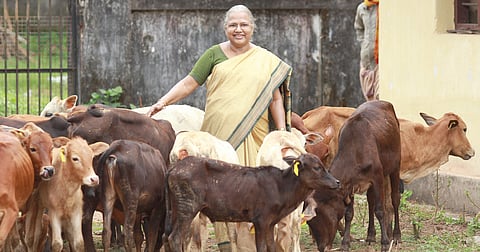Holy Cow Small Packs a Big Punch
The Vechur cow was on the brink of extinction in 1989 when Sosamma Iype, professor of animal breeding and genetics, along with likeminded conservationists in Kerala, rolled up their sleeves and worked relentlessly to save the rare animal through a conservation project that has spanned 25 years.
This month, the Vechur Conservation Trust, a body formed to conserve domestic animal diversity, is on a mission to electronically tag all Vechur cows in the country to check the ‘genetic pollution’ of the breed in the 25th year of the conservation project.
“The decision to tag the animals was taken following a series of complaints of genetic pollution of the species after calves of Vechur cow bred with local ox varieties were sold as Vechur cows in the market,” says Sosamma.
The Trust will soon launch new Vechur cow products such as distilled Vechur cow urine that helps in treating high BP, high blood cholesterol, diabetes, asthma, and other diseases.
Sosamma says it will take some time to implant the microchips on around 3,000 Vechur cows spread across the country. The cow is a rare breed of Bos indicus cattle that has an average length of 124 cm and height of 87 cm.
Named after the village Vechoor in Kottayam, Kerala, the cow, the smallest indigenous breed in the world ccording to the Guinness Book of Records, was valued for the large amount of milk it produced despite being requiring not as much feed. “It was the conservation project initiated by the Kerala Agriculture University in 1988 under my stewardship along with a group of vet students that created a rare milestone in the conservation of this cow,” says Sosamma.
When the idea of working to safeguard the threatened breed took shape in 1988, the then Kerala Government had been actively promoting the massive cross-breeding programmes with exotic bulls to increase milk production under the Kerala Livestock Improvement Act. So Sosamma and her team were virtually going against the policy of the state government. “I had to face a lot of hardships in our fight for safeguarding the rare breed that would otherwise be destined for oblivion,” she said.
“In the early 90s, Sosamma and her husband Dr Abraham Varky, who is also a veterinarian, along with a group of young vet graduates had spent years searching for purebred animals of Vechoor by travelling to remote villages in Pathnamthitta and Kottayam to find communities of local breeders, who raise the rare breed,” says T P ethumadhavan, director of entrepreneurship, Kerala Veterinary and Animal Sciences University.
The group also had to deal with scepticism from environmentalists and a section of colleagues. Detractors alleged the team was working against the government policy by reintroducing an unproductive species. Not just that Sosamma was accused of colluding with the Roslin Institute in Edinburgh to patent the cow’s genetic code when the project became a success. Investigation into the charges proved they were false, says Sethumadhavan.
The Kerala government, which once opposed the project, is now giving subsidies to Vechoor breeders to promote them when the cow turned out to be one of the most sought after livestock in the dairy sector of the country, says Dr Abraham Varky.
Though the cow yields only around 2.5 litres milk per day on an average, it has high medicinal values and contains the small fat globule, A2 beta-lactalbumin protein.

